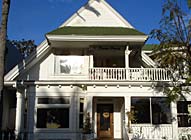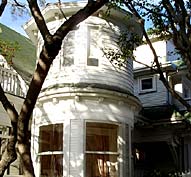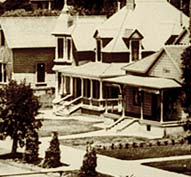




1333 Ocean Ave.


1333 Ocean Ave
photo by Michael Grandcolas

View of turret
photo by Michael Grandcolas

Square bay house on Ocean Avenue, CA - 1900
What, exactly, is a Victorian? Many people use the term to describe an architectural style. However, Victorian is not really a style but a period in history. The Victorian era dates from about 1840 to 1900. During this time, industrialization brought many innovations in architecture. There are a variety of Victorian styles, each with its own distinctive features.
The most popular Victorian styles spread quickly through widely published pattern books. Builders often borrowed characteristics from several different styles, creating unique, and sometimes quirky, mixes. Buildings like the one at 1333 Ocean Avenue constructed during the Victorian times usually have several personalized characteristics including asymmetrical shape, brackets under the eaves and porches with spindlework or flat, jigsaw cut trim.
Here we have no exceptions. This house was originally designed as a single-family residence. Roofline features on this clapboard-clad building include boxed eaves, exposed rafter details, dentils molding, and a steeply pitched roof. Also note the two-story shingled tower style. In the style of a Free Classic Victorian, note this property’s classical pillar columns. Queen Anne architectural elements include bay windows, balconies, stained glass, turrets, porches, brackets and an abundance of decorative details combined in unexpected ways.
Popular during the time of Britain's Queen Victoria, Queen Anne architecture borrowed ideas from the earlier Medieval era. In the United States, Queen Anne houses became lofty, sometimes fanciful, expressions of the machine age. From New York to California, rows of imposing Queen Anne homes stand as monuments to the industrialists who prospered there.
Ironically, the very qualities that made Queen Anne architecture so regal also made it fragile. These expansive and expressive buildings proved expensive and difficult to maintain. By the turn of the century, Queen Annes had fallen out of favor. In the early 1900s, architects favored smaller Edwardian ("Princess Anne") and more austere Colonial Revival styles.